fuel Peugeot 508 2010.5 User Guide
[x] Cancel search | Manufacturer: PEUGEOT, Model Year: 2010.5, Model line: 508, Model: Peugeot 508 2010.5Pages: 330, PDF Size: 11.68 MB
Page 28 of 330

28
Instruments and controls
is onCauseAction/Obser vations
Dynamic stability control (ESP/ASR)
flashing. The ESP/ASR regulation is active. The system optimises traction and improves the directional stability of the vehicle.
fixed. Unless it has been deactivated with the indicator lamp in the button on, the ESP/ASR system has a fault.
Have it checked by a PEUGEOT or a qualified workshop.
Engine autodiagnosis system
fixed. The emission control system has a fault. The warning lamp should go off when the engine is started. If it does not go off, contact a PEUGEOT dealer or qualified workshop urgently.
flashing. The engine management system has a fault. Risk of destruction of the catalytic conver ter. Have it checked by a PEUGEOT dealer or a qualified workshop.
Low fuel level fixed with the needle in the red zone. When it first comes on there remains approximately 7 litres of fuel in the tank.
At this point, you begin to use the fuel reser ve.
Refuel as soon as possible to avoid running out of fuel. This warning lamp will come on every time the ignitio n
is switched on, until a sufficient addition of fuel is made. Never continue to drive until you run out of fuel, as this could damage the emission control and injection systems.
Anti-lock Braking System (ABS)
fixed. The anti-lock braking system has a fault. The vehicle retains conventional braking. Drive carefully at reduced speed and contact a PEUGEOT dealer or a qualified workshop without delay.
Page 37 of 330
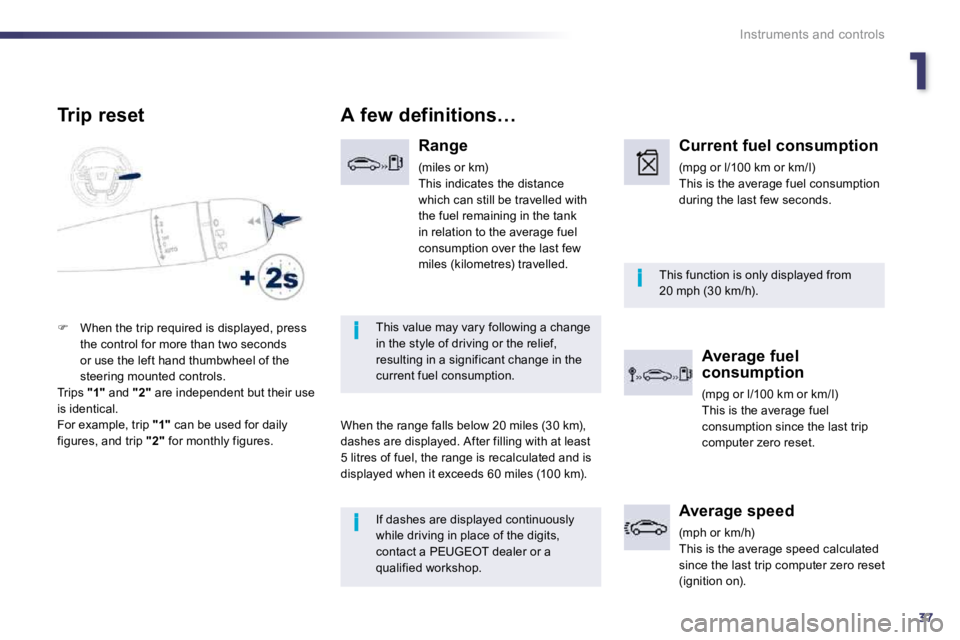
137
i
i
i
Instruments and controls
If dashes are displayed continuously
while driving in place of the digits, contact a PEUGEOT dealer or a qualified workshop.
This function is only displayed from 20 mph (30 km/h).
This value may vary following a change in the style of driving or the relief, resulting in a significant change in the current fuel consumption.
A few definitions…
Range
(miles or km) This indicates the distance which can still be travelled with the fuel remaining in the tank
in relation to the average fuel consumption over the last few miles (kilometres) travelled.
When the range falls below 20 miles (30 km),
dashes are displayed. After filling with at least 5 litres of fuel, the range is recalculated and is displayed when it exceeds 60 miles (100 km).
Current fuel consumption
(mpg or l/100 km or km/l) This is the average fuel consumption during the last few seconds.
Average fuel consumption
(mpg or l/100 km or km/l) This is the average fuel consumption since the last trip computer zero reset.
Average speed
(mph or km/h) This is the average speed calculated since the last trip computer zero reset (ignition on).
Trip reset
� When the trip required is displayed, press the control for more than two seconds or use the left hand thumbwheel of the steering mounted controls. Trips "1" and "2" are independent but their use is identical. For example, trip "1" can be used for daily
figures, and trip "2" for monthly figures.
Page 66 of 330
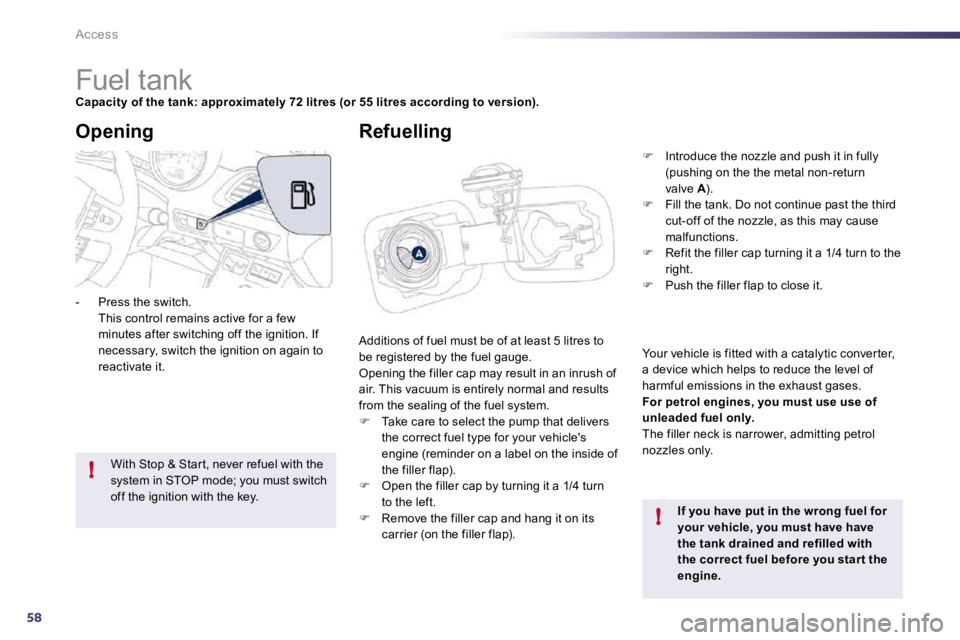
58
!
!
Access
Fuel tank
Capacity of the tank: approximately 72 litres (or 55 litres according to version).
Additions of fuel must be of at least 5 litres to be registered by the fuel gauge. Opening the filler cap may result in an inrush of air. This vacuum is entirely normal and results from the sealing of the fuel system. � Take care to select the pump that delivers
the correct fuel type for your vehicle's engine (reminder on a label on the inside of the filler flap).
� Open the filler cap by turning it a 1/4 turn to the left. � Remove the filler cap and hang it on its
carrier (on the filler flap).
Opening
If you have put in the wrong fuel for your vehicle, you must have have
the tank drained and refilled with the correct fuel before you star t the engine.
With Stop & Star t, never refuel with the
system in STOP mode; you must switch off the ignition with the key.
- Press the switch. This control remains active for a few minutes after switching off the ignition. If necessary, switch the ignition on again to reactivate it.
Refuelling
� Introduce the nozzle and push it in fully (pushing on the the metal non-return valve A ).A� Fill the tank. Do not continue past the third cut-off of the nozzle, as this may cause malfunctions. � Refit the filler cap turning it a 1/4 turn to the right. � Push the filler flap to close it.
Your vehicle is fitted with a catalytic conver ter, a device which helps to reduce the level of harmful emissions in the exhaust gases. For petrol engines, you must use use of unleaded fuel only. The filler neck is narrower, admitting petrol nozzles only.
Page 67 of 330
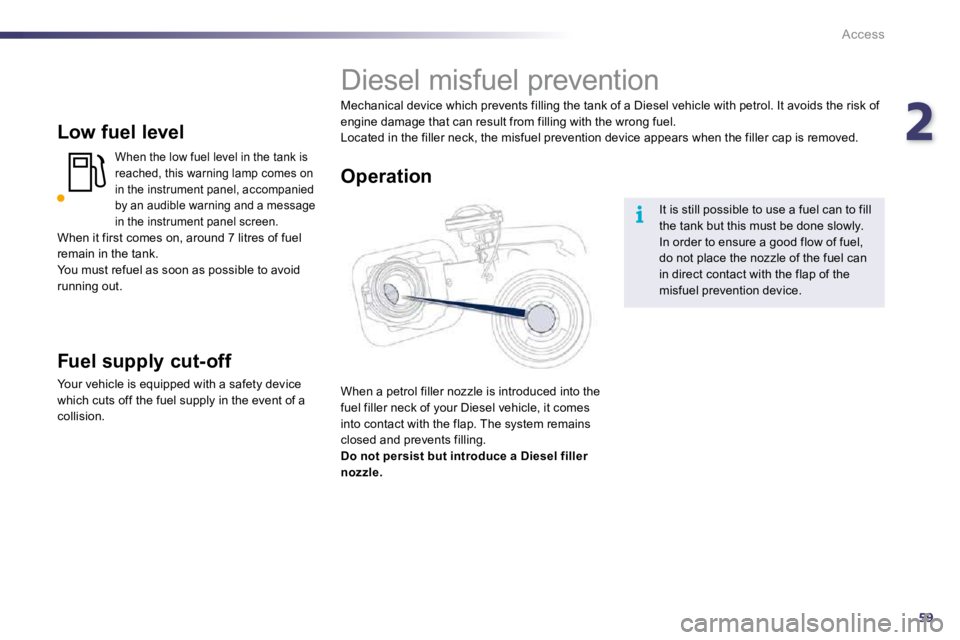
259
i
Access
Low fuel level
When the low fuel level in the tank is reached, this warning lamp comes on in the instrument panel, accompanied by an audible warning and a message in the instrument panel screen. When it first comes on, around 7 litres of fuel remain in the tank. You must refuel as soon as possible to avoid running out.
Fuel supply cut-off
Your vehicle is equipped with a safety device which cuts off the fuel supply in the event of a collision.
It is still possible to use a fuel can to fill
the tank but this must be done slowly. In order to ensure a good flow of fuel, do not place the nozzle of the fuel can in direct contact with the flap of the misfuel prevention device.
Diesel misfuel prevention
Mechanical device which prevents filling the tank of a Diesel vehicle with petrol. It avoids the risk of engine damage that can result from filling with the wrong fuel. Located in the filler neck, the misfuel prevention device appears when the filler cap is removed.
When a petrol filler nozzle is introduced into the fuel filler neck of your Diesel vehicle, it comes into contact with the flap. The system remains
closed and prevents filling. Do not persist but introduce a Diesel filler nozzle.
Operation
Page 68 of 330
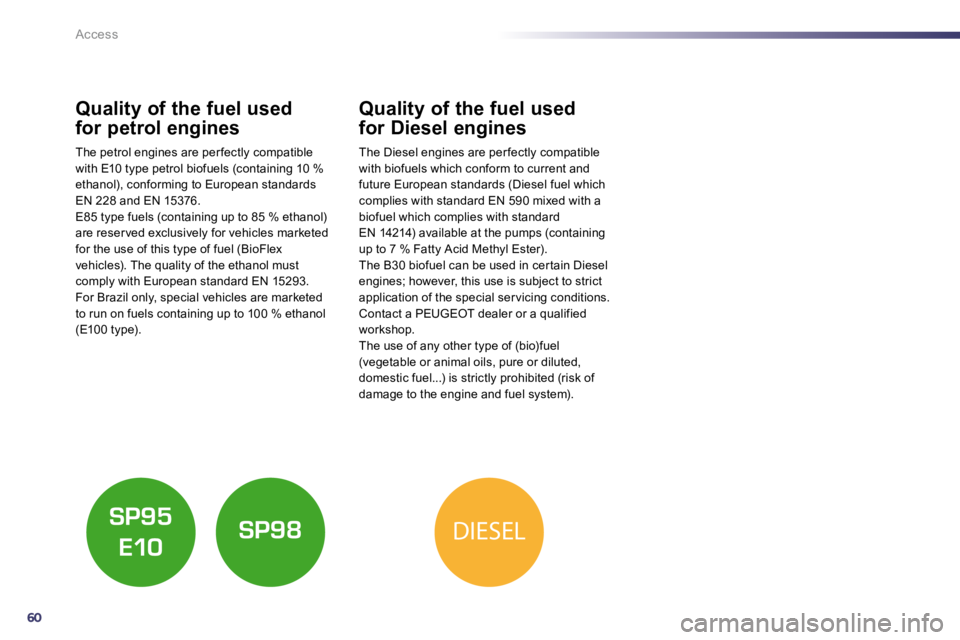
60
DIESEL
Access
Quality of the fuel used
for petrol engines
The petrol engines are per fectly compatible with E10 type petrol biofuels (containing 10 % ethanol), conforming to European standards EN 228 and EN 15376. E85 type fuels (containing up to 85 % ethanol) are reser ved exclusively for vehicles marketed for the use of this type of fuel (BioFlex vehicles). The quality of the ethanol must comply with European standard EN 15293. For Brazil only, special vehicles are marketed to run on fuels containing up to 100 % ethanol (E100 type).
Quality of the fuel used
for Diesel engines
The Diesel engines are per fectly compatible with biofuels which conform to current and future European standards (Diesel fuel which complies with standard EN 590 mixed with a biofuel which complies with standardEN 14214) available at the pumps (containing up to 7 % Fatty Acid Methyl Ester). The B30 biofuel can be used in cer tain Diesel engines; however, this use is subject to strict application of the special ser vicing conditions. Contact a PEUGEOT dealer or a qualified workshop. The use of any other type of (bio)fuel (vegetable or animal oils, pure or diluted, domestic fuel...) is strictly prohibited (risk of damage to the engine and fuel system).
Page 91 of 330
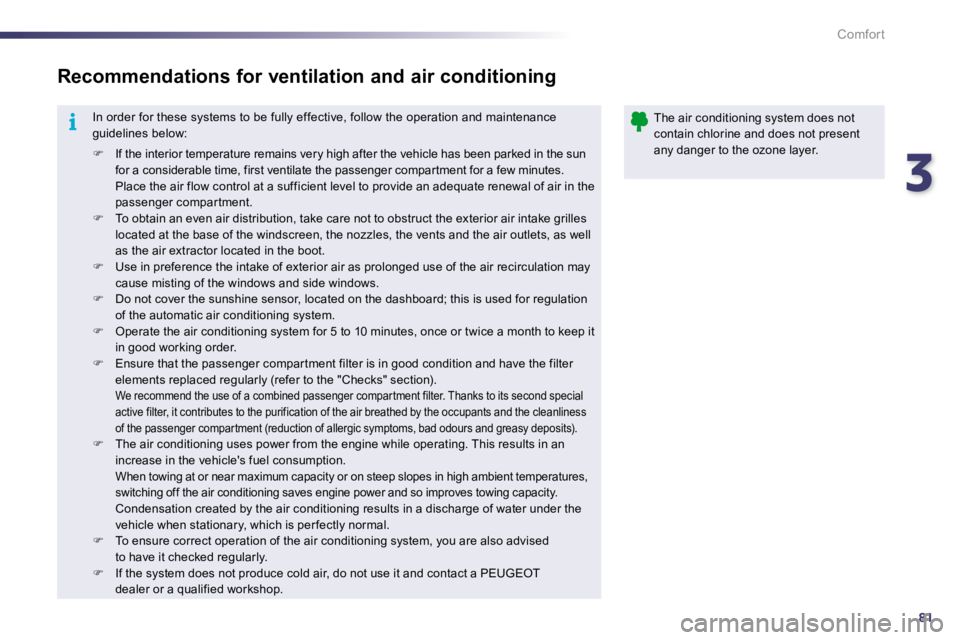
381
i
Comfort
In order for these systems to be fully effective, follo w the operation and maintenance guidelines below:
� If the interior temperature remains very high after the vehicle has been parked in the sun for a considerable time, first ventilate the passeng er compartment for a few minutes. Place the air flow control at a sufficient level to provide an adequate renewal of air in the passenger compar tment. � To obtain an even air distribution, take care not to obstruct the exterior air intake grilles located at the base of the windscreen, the nozzles, the vents and the air outlets, as well as the air extractor located in the boot. � Use in preference the intake of exterior air as prol onged use of the air recirculation may cause misting of the windows and side windows. � Do not cover the sunshine sensor, located on the d ashboard; this is used for regulation of the automatic air conditioning system. � Operate the air conditioning system for 5 to 10 minut es, once or twice a month to keep it in good working order. � Ensure that the passenger compar tment filter is in good condition and have the filter elements replaced regularly (refer to the "Checks" secti on). We recommend the use of a combined passenger compa rtment filter. Thanks to its second special active filter, it contributes to the purification of the air breathed by the occupants and the cleanli ness of the passenger compartment (reduction of allergic symptoms, bad odours and greasy deposits). � The air conditioning uses power from the engine while operating. This results in an increase in the vehicle's fuel consumption. When towing at or near maximum capacity or on steep slopes in high ambient temperatures, switching off the air conditioning saves engine power and so improves towing capacity. Condensation created by the air conditioning results in a discharge of water under the vehicle when stationary, which is per fectly normal. � To ensure correct operation of the air conditioning system, you are also advised to have it checked regularly. � If the system does not produce cold air, do not use it and contact a PEUGEOT
dealer or a qualified workshop.
Recommendations for ventilation and air conditionin g
The air conditioning system does not contain chlorine and does not present any danger to the ozone layer.
Page 102 of 330
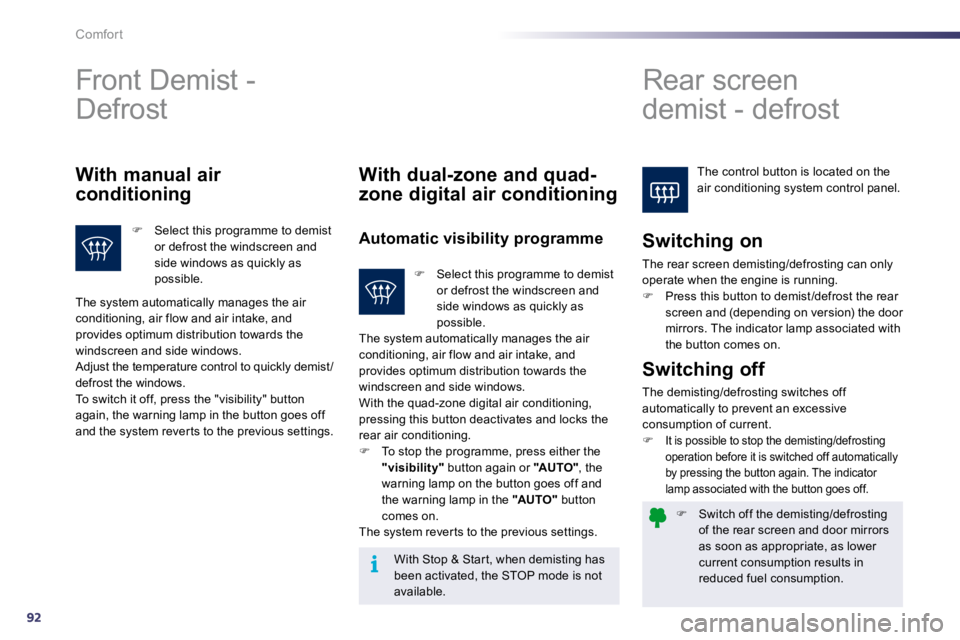
92
i
Comfort
� Switch off the demisting/defrosting of the rear screen and door mirrors as soon as appropriate, as lower current consumption results in reduced fuel consumption.
Front Demist -
Defrost Rear screen
demist - defrost
The control button is located on the air conditioning system control panel. With manual air
conditioning
� Select this programme to demist or defrost the windscreen and side windows as quickly as possible.
With dual-zone and quad-
zone digital air conditioning
Automatic visibility programme Switching on
The rear screen demisting/defrosting can only operate when the engine is running. � Press this button to demist /defrost the rear screen and (depending on version) the door mirrors. The indicator lamp associated with the button comes on.
With Stop & Star t, when demisting has been activated, the STOP mode is not available.
Switching off
The demisting/defrosting switches off automatically to prevent an excessive consumption of current. �It is possible to stop the demisting/defrosting operation before it is switched off automatically by pressing the button again. The indicator
lamp associated with the button goes off.
The system automatically manages the air conditioning, air flow and air intake, and provides optimum distribution towards the windscreen and side windows. Adjust the temperature control to quickly demist/defrost the windows. To switch it off, press the "visibility" button again, the warning lamp in the button goes off and the system rever ts to the previous settings.
� Select this programme to demist or defrost the windscreen and side windows as quickly as possible. The system automatically manages the air conditioning, air flow and air intake, and provides optimum distribution towards the windscreen and side windows. With the quad-zone digital air conditioning, pressing this button deactivates and locks the
rear air conditioning. � To stop the programme, press either the "visibility" button again or "AUTO" , the
warning lamp on the button goes off and the warning lamp in the "AUTO" button comes on. The system rever ts to the previous settings.
Page 117 of 330
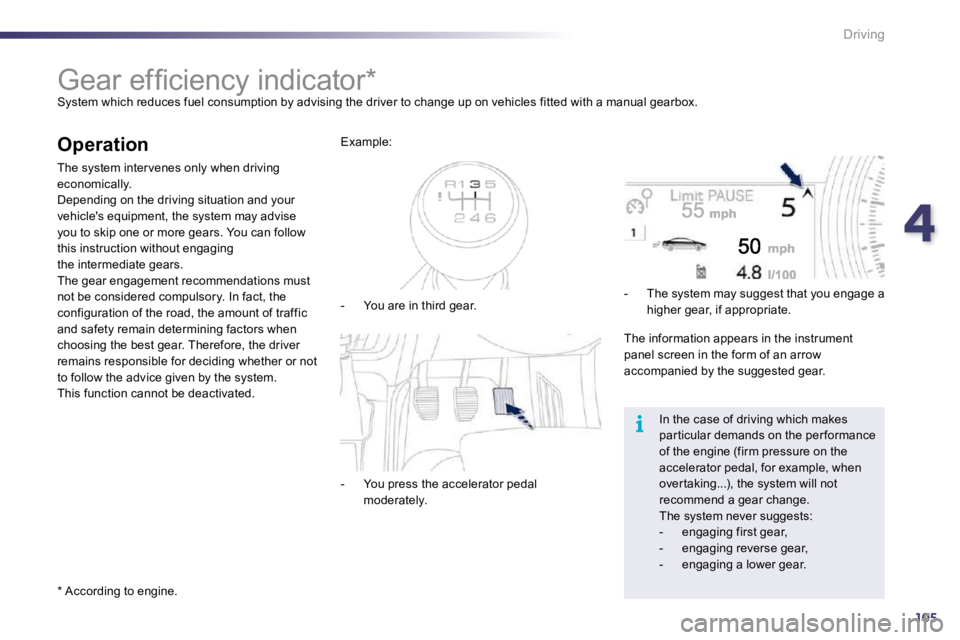
4105
i
Driving
�G�e�a�r� �e�f�fi� �c�i�e�n�c�y� �i�n�d�i�c�a�t�o�r� �*� �
System which reduces fuel consumption by advising the driver to change up on vehicles fitted with a manual gearbox.
Operation
The system inter venes only when driving economically. Depending on the driving situation and your vehicle's equipment, the system may advise you to skip one or more gears. You can follow this instruction without engagingthe intermediate gears. The gear engagement recommendations must not be considered compulsory. In fact, the configuration of the road, the amount of traffic and safety remain determining factors when choosing the best gear. Therefore, the driver remains responsible for deciding whether or not to follow the advice given by the system. This function cannot be deactivated.
� � �*� � � �A�c�c�o�r�d�i�n�g� �t�o� �e�n�g�i�n�e�.� �
- You are in third gear.
Example:
- You press the accelerator pedal moderately.
- The system may suggest that you engage a higher gear, if appropriate.
The information appears in the instrument panel screen in the form of an arrow accompanied by the suggested gear.
In the case of driving which makes par ticular demands on the per formance of the engine (firm pressure on the accelerator pedal, for example, when
over taking...), the system will not recommend a gear change. The system never suggests: - engaging first gear,
- engaging reverse gear, - engaging a lower gear.
Page 121 of 330
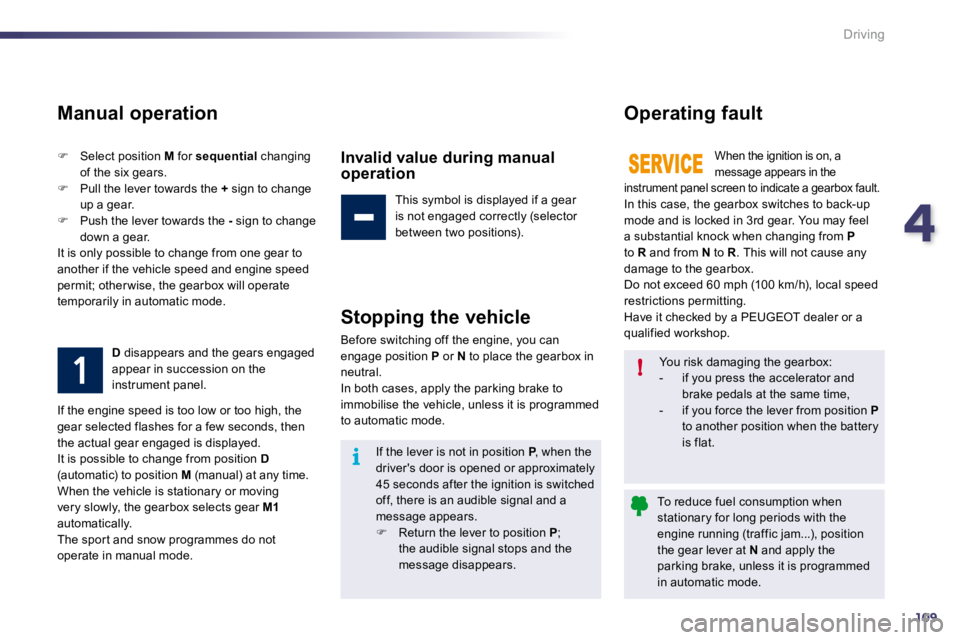
4109
i
!
Driving
Manual operation
� Select position M for sequential changing of the six gears. � Pull the lever towards the + sign to change up a gear. � Push the lever towards the - sign to change down a gear. It is only possible to change from one gear to another if the vehicle speed and engine speed permit; other wise, the gearbox will operate temporarily in automatic mode.
D disappears and the gears engaged appear in succession on the instrument panel.
Invalid value during manual operation
This symbol is displayed if a gear is not engaged correctly (selector between two positions).
Stopping the vehicle
Before switching off the engine, you can engage position P or N to place the gearbox in neutral. In both cases, apply the parking brake to immobilise the vehicle, unless it is programmed to automatic mode.
Operating fault
When the ignition is on, a message appears in the instrument panel screen to indicate a gearbox fault . In this case, the gearbox switches to back-up mode and is locked in 3rd gear. You may feel a substantial knock when changing from Pto R and from N to R . This will not cause any damage to the gearbox. Do not exceed 60 mph (100 km/h), local speed restrictions permitting. Have it checked by a PEUGEOT dealer or a qualified workshop.
If the engine speed is too low or too high, the gear selected flashes for a few seconds, then the actual gear engaged is displayed. It is possible to change from position D
(automatic) to position M (manual) at any time. When the vehicle is stationary or moving very slowly, the gearbox selects gear M1automatically. The spor t and snow programmes do not operate in manual mode.
You risk damaging the gearbox: - if you press the accelerator and brake pedals at the same time, - if you force the lever from position Pto another position when the battery
is flat. If the lever is not in position P , when the Pdriver's door is opened or approximately
45 seconds after the ignition is switched off, there is an audible signal and a message appears. � Return the lever to position P ; the audible signal stops and the message disappears.
To reduce fuel consumption when stationary for long periods with the engine running (traffic jam...), position the gear lever at N and apply the parking brake, unless it is programmed in automatic mode.
Page 126 of 330
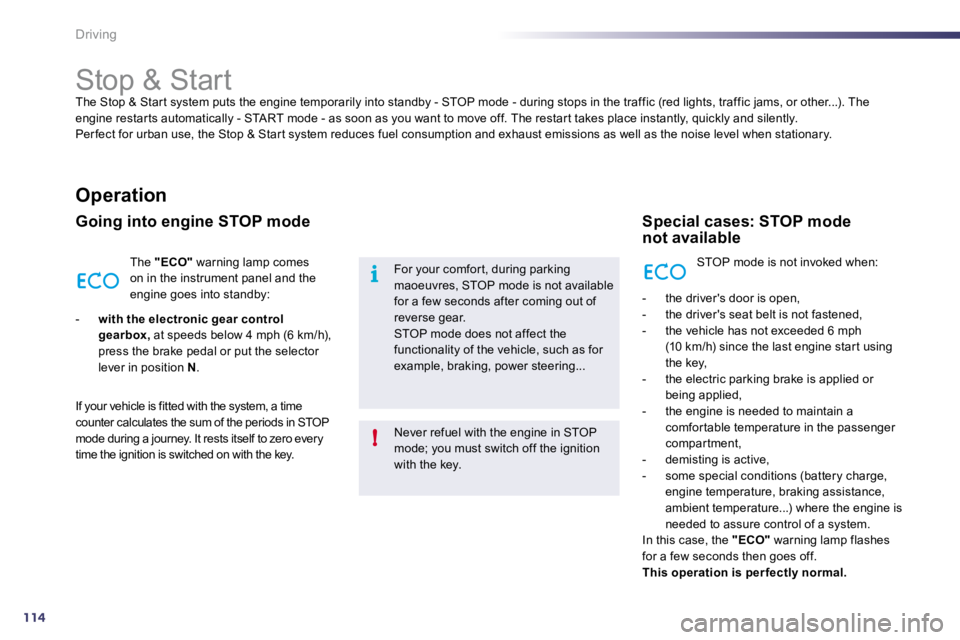
114
i
!
Driving
Stop & Start
The Stop & Star t system puts the engine temporarily into standby - STOP mode - during stops in the traffic (red lights, traffic jams, or other...). The engine restar ts automatically - START mode - as soon as y ou want to move off. The restar t takes place instantly, quickly and silently. Per fect for urban use, the Stop & Star t system reduce s fuel consumption and exhaust emissions as well as the noise level when stationary.
Operation
Going into engine STOP mode
The "ECO" warning lamp comes on in the instrument panel and the engine goes into standby:
- with the electronic gear control gearbox, at speeds below 4 mph (6 km/h), press the brake pedal or put the selector lever in position N .
If your vehicle is fitted with the system, a time counter calculates the sum of the periods in STOP mode during a journey. It rests itself to zero every time the ignition is switched on with the key.
Never refuel with the engine in STOP mode; you must switch off the ignition with the key.
For your comfor t, during parking maoeuvres, STOP mode is not available for a few seconds after coming out of reverse gear. STOP mode does not affect the functionality of the vehicle, such as for example, braking, power steering...
Special cases: STOP mode not available
STOP mode is not invoked when:
- the driver's door is open, - the driver's seat belt is not fastened, - the vehicle has not exceeded 6 mph (10 km/h) since the last engine star t using the key, - the electric parking brake is applied or being applied, - the engine is needed to maintain a comfor table temperature in the passenger compar tment, - demisting is active,
- some special conditions (battery charge, engine temperature, braking assistance, ambient temperature...) where the engine is needed to assure control of a system. In this case, the "ECO" warning lamp flashes for a few seconds then goes off. This operation is per fectly normal.